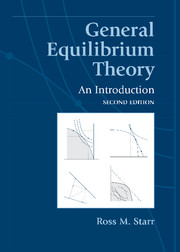Book contents
- Frontmatter
- Contents
- List of illustrations
- Introduction to the second edition
- Preface to the second edition
- Preface to the first edition
- Table of notation
- Table of assumptions
- A General equilibrium theory: Getting acquainted
- B Mathematics
- 6 Logic and set theory
- 7 RN: Real N-dimensional Euclidean space
- 8 Convex sets, separation theorems, and nonconvex sets in RN
- 9 The Brouwer Fixed-Point Theorem
- C An economy with bounded production technology and supply and demand functions
- D An economy with unbounded production technology and supply and demand functions
- E Welfare economics and the scope of markets
- F Bargaining and equilibrium: The core
- G An economy with supply and demand correspondences
- H Standing on the shoulders of giants
- Bibliography
- Index
9 - The Brouwer Fixed-Point Theorem
from B - Mathematics
Published online by Cambridge University Press: 05 June 2012
- Frontmatter
- Contents
- List of illustrations
- Introduction to the second edition
- Preface to the second edition
- Preface to the first edition
- Table of notation
- Table of assumptions
- A General equilibrium theory: Getting acquainted
- B Mathematics
- 6 Logic and set theory
- 7 RN: Real N-dimensional Euclidean space
- 8 Convex sets, separation theorems, and nonconvex sets in RN
- 9 The Brouwer Fixed-Point Theorem
- C An economy with bounded production technology and supply and demand functions
- D An economy with unbounded production technology and supply and demand functions
- E Welfare economics and the scope of markets
- F Bargaining and equilibrium: The core
- G An economy with supply and demand correspondences
- H Standing on the shoulders of giants
- Bibliography
- Index
Summary
The Brouwer Fixed-Point Theorem is a profound and powerful result. It turns out to be essential in proving the existence of general equilibrium. We have already seen that it is convenient (in Chapter 5), but it can be shown to be indispensable (Chapter 18).
The Brouwer Fixed-Point Theorem says that a continuous function from a compact convex set into itself has a fixed point. There is at least one point that is left unchanged by the mapping. Note that the convexity is essential. For example, the fixed point property is not true (and the theorem is inapplicable) for a function mapping the circumference of a circle into itself. Indeed, typical of well-constructed mathematical results, all of the assumptions are essential. The fixed-point property will not hold for a discontinuous function or on an open or unbounded set.
In R, the Brouwer Fixed-Point Theorem takes a particularly simple form, equivalent to the Intermediate Value Theorem. Let f map the closed interval [a, b] into itself. Then the theorem is equivalent to the assertion that every continuous curve y = f(x) from one side of the square [a, b] × [a, b] to the opposite side must intersect the diagonal (the line y = x). See Figure 9.1.
Economic applications do not require that the economist know or understand the proof of the Brouwer Theorem.
- Type
- Chapter
- Information
- General Equilibrium TheoryAn Introduction, pp. 99 - 108Publisher: Cambridge University PressPrint publication year: 2011



